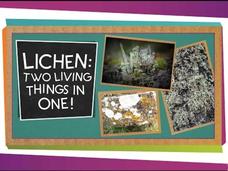Curated OER
Rockies Thrust Up
How did Colorado's Front Range arise when it's 1,000 miles from where the Pacific and North American plates meet? Learn about the theory behind this oddity and use this video to springboard into other topics, such as what types of rocks...
Scholastic
Study Jams! Volcanoes
You will lava this little clip about volcanoes! It explains what a volcano is and describes the four different types. It also addresses how magma flows through a conduit, passes through a vent, and becomes lava. All of this takes place...
Fuse School
Future Extraction Methods
How do plants and bacteria help us gain access to our Earth's precious copper reserves? Scholars gain knowledge of the processes of bioleaching and phytomining in the seventh and final installment in a series discussing rocks and their...
Flocabulary
What Are Pronouns?
Once upon a time, SchoolHouse Rock used Rufus Xavier Sarsparilla to teach a lesson pronouns. Featuring an updated song, the third of four videos in a Language Arts playlist, uses a catchy hip-hop tune to teach about pronoun-antecedent...
PBS
Cnidarians: Anemone Swims Away from Sea Star
While most sea anemones move slowly along rocks, Stomphia swim to escape predators. Viewers see a sea star sneak up on an anemone ready to attack. The unsuspecting anemone retaliates quickly and swims away awkwardly as part of a larger...
The Brain Scoop
Fossil Meteorites
Fossils ... from space? Science scholars discover evidence in a limestone quarry that helped researchers learn about a meteor shower that lasted hundreds of thousands of years through an interesting video from Brain Scoop's Fossils and...
Bozeman Science
LS4C - Adaptation
Learn how the study of adaptation progresses through grade levels. The narrator provides a curricular view of teaching adaptation complete with examples. Concepts range from simple trait adaptations to speciation and natural selection.
SciShow Kids
Lichen: Two Living Things In One
What do fungus and algae create? Lichen! Discover where lichen lives, how it survives, and how to find the three main types of lichen in a video all about lichen!
The Brain Scoop
Meteorites From Spaaaaaace!
Eighty thousand tons of material enters Earth's atmosphere every year. The video, part of a playlist from Brain Scoop on Fossils and Geology, focuses on meteorites. It defines the three types and explains which are most and least common....
Kurzgesagt – In a Nutshell
How to Catch a Dwarf Planet—Triton
Neptune has more than its share of moons with 14, although Triton takes the prize for the largest. Study the origin and behavior of Neptune's moons with a video lesson from the Kurzgesagt playlist.
Scholastic
Study Jams! Earthquakes
Have a seismic moment with your class as you show this animated video on earthquakes. Viewers find that quakes occur on faults and are caused by shifting of continental plates. They learn what properties are studied by seismologists and...
MinuteEarth
Plate Tectonics Explained
Ready to teach plate tectonics but not sure where to begin? Start with a short video that is long on learning! Junior earth scientists discover the basics of plate tectonics, complete with colorful analogies and explanations. The...
Be Smart
Asteroid Mining: Our Ticket To Living Off Earth?
It turns out asteroids could be a gold mine—literally! An It's Ok To Be Smart video lesson describes the untapped resources orbiting our solar system. The presenter considers the possibilities of space colonies using these resources as...
Curated OER
How Do Crystals Form?
Once again, a teacher is videotaped while lecturing his class when describing how crystals form and grow. It feels like you're sitting in a college classroom and taking a lecture from a very good instructor. His speaking style is...
Curated OER
Identifying Minerals
A teacher is videotaped while lecturing to his class regarding properties of minerals. He explains that the things geologists look for when identifying minerals is the color of the mineral itself, the "streak" color a mineral makes when...
Veritasium
The Most Radioactive Places on Earth
Spoiler alert! The most radioactive place on Earth may be much closer than you think! Explore some of the world's radioactive hot spots with an engaging video from the Veritasium playlist. Content includes the units used to measure...
Other popular searches
- Three Types of Rocks
- 3 Types of Rocks
- Different Types of Rocks
- +3 Types of Rocks
- Rocks Types
- Differant Types of Rocks
- Identifying Types of Rocks
- Describe Types of Rocks
- Differ Ant Types of Rocks
- 3 Types of Rocks Lab
- Rocks Types and Weathering
- Creating Three Types of Rocks
















